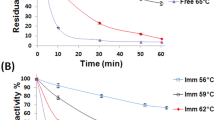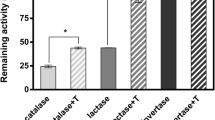ABSTRACT
Purpose
The purpose of this study is to show how disaccharides differ in their ability to protect lyophilized β-galactosidase from enzymatic activity loss and secondary structure changes during storage.
Methods
β-galactosidase was lyophilized with trehalose, sucrose, cellobiose or melibiose at 2:1, 20:1 and 40:1 excipient/protein weight ratios, and stored up to 90 days at 45°C. Protein enzymatic activity was studied using o-nitrophenyl-β-d-galactopyranoside cleavage test, and its secondary structure in lyophilizates analyzed using Fourier transform infrared spectroscopy. The crystallization tendencies, glass transition temperatures and water contents of lyophilizates were evaluated using x-ray powder diffractometry, differential scanning calorimetry and thermogravimetry, respectively.
Results
The enzymatic activity of β-galactosidase decreased more slowly in lyophilizates containing trehalose or melibiose at 2:1 excipient/protein weight ratio when compared to those containing sucrose or cellobiose. Similar behavior was observed when analyzing the protein’s secondary structure in lyophilizates. In 20:1 and 40:1 excipient/protein weight ratio lyophilizates the decrease of enzymatic activity was less dependent on the excipient, but activity was always amongst the highest in melibiose lyophilizates.
Conclusions
Melibiose was shown to be effective in protecting lyophilized β-galactosidase during storage. The protein secondary structure was shown to change at comparable rate in lyophilizates as its enzymatic activity after rehydration.





Similar content being viewed by others
REFERENCES
Wang W. Lyophilization and development of solid protein pharmaceuticals. Int J Pharm. 2000;203:1–60.
Carpenter JF, Prestrelski SJ, Dong A. Application of infrared spectroscopy to development of stable lyophilized protein formulations. Eur J Pharm Biopharm. 1998;45:231–8.
Hagen SJ, Hofrichter J, Eaton WA. Protein reaction kinetics in a room-temperature glass. Science. 1995;269:959–62.
Allison SD, Dong A, Carpenter JF. Counteracting effects of thiocyanate and sucrose on chymotrypsinogen secondary structure and aggregation during freezing, drying, and rehydration. Biophys J. 1996;71:2022–32.
Izutsu K, Yoshioka S, Terao T. Decreased protein-stabilizing effects of cryoprotectants due to crystallization. Pharm Res. 1993;10:1232–7.
Yoshioka S, Miyazaki T, Aso Y, Kawanishi T. Significance of local mobility in aggregation of b-galactosidase lyophilized with trehalose, sucrose or stachyose. Pharm Res. 2007;24:1660–7.
Chang L, Shepherd D, Sun J, Quellette D, Grant K, Xiaolin C, et al. Mechanism of protein stabilization by sugars during freeze-drying and storage: Native structure preservation, specific interaction and/or immobilization in a glassy matrix? J Pharm Sci. 2005;94:1427–44.
Costantino HR, Carrasquillo KG, Cordero RA, Mumenthaler M, Hsu CC, Griebenow K. Effect of excipients on the stability and structure of lyophilized recombinant human growth hormone. J Pharm Sci. 1998;87:1412–20.
Prestrelski S, Tedeschi N, Arakawa T, Carpenter JF. Dehydration-induced conformational transitions in proteins and their inhibition by stabilizers. Biophys J. 1993;65:661–71.
Surewicz WK, Mantsch HH, Chapman D. Determination of protein secondary structure by Fourier transform infrared spectroscopy: a critical assessment. Biochem. 1993;32:389–94.
Muga A, Arrondo JLR, Sancho BTJ, Bernabeu C. Structural and functional strudies on the interaction of sodium dodecyl sulfate with b-galactosidase. Arch Biochem Biophys. 1993;300:451–7.
Sambrook J, Fritsch EF, Maniatis T. Molecular cloning: a laboratory manual. New York: Cold Spring Harbor Laboratory Press; 1989.
Arrondo JLR, Muga A, Castresana J, Bernabeu C, Goni FM. An infrared spectroscopic study of b-galactosidase structure in aqueous solutions. FEBS Letters. 1989;252:118–20.
Cooper EA, Knutson K. Fourier transform infrared spectroscopy investigations of protein structure. In: Herron JN, Jiskoot W, Crommelin D, editors. Physical methods to characterize pharmaceutical proteins. New York: Plenum; 1995. p. 101–43.
Dong A, Huang P, Caughey WS. Protein secondary structures in water from second-derivative amide I infrared spectra. Biochem. 1990;29:3303–8.
Wold S, Sjostrom M, Eriksson L. PLS-regression: a basic tool of chemometrics. Chemom Intell Lab Syst. 2001;58:109–30.
Aaltonen J, Kogermann K, Strachan CJ, Rantanen J. In-line monitoring of solid-state transitions during fluidisation. Chem Eng Sci. 2006;62:408–15.
Virtanen S, Antikainen O, Yliruusi J. Determination of the crushing strength of intact tablets using Raman spectroscopy. Int J Pharm. 2008;360:40–6.
Pikal MJ, Roy ML, Shah S. Mass and heat transfer in vial freeze-drying of pharmaceuticals: role of the vial. J Pharm Sci. 1984;73:1224–37.
May JC, Grim E, Wheeler RM, West J. Determination of residual moisture in freeze-dried viral vaccines: Karl Fischer, gravimetric and thermogravimetric methodologies. J Biol Stand. 1982;10:249–59.
Chang L, Shepherd D, Sun J, Tang X, Pikal MJ. Effect of sorbitol and residual moisture on the stability of lyophilized antibodies: implications for the mechanism of protein stabilization in the solid state. J Pharm Sci. 2005;94:1445–55.
Roos YH. Frozen state transitions in relation to freeze drying. J Therm Anal. 1997;48:535–44.
Hinrichs WLJ, Sanders NN, De Smedt SC, Demeester J, Frijlink HW. Inulin is a promising cryo- and lyoprotectant for PEGylated lipoplexes. J Control Release. 2005;103:465–79.
Orford PD, Parker R, Ring SG. Aspects of the glass transition behavior of mixtures of carbohydrates of low molecular weight. Carbohydr Res. 1990;196:11–8.
Taylor LS, Zografi G. Sugar-polymer hydrogen bond interactions in lyophilized amorphous mixtures. J Pharm Sci. 1998;87:1615–21.
Simperler A, Kornherr A, Chopra R, Jones W, Motherwell WDS, Zifferer G. The glass transition temperatures of amorphous trehalose-water mixtures and the mobility of water: an experimental and in silico study. Carbohydr Res. 2007;342:1470–9.
Hancock BC, Zografi G. The relationship between the glass transition temperature and the water content of amorphous pharmaceutical solids. Pharm Res. 1994;11:471–7.
Shamblin SL, Tang X, Chang L, Hancock BC, Pikal MJ. Characterization of the time scales of molecular motion in pharmaceutically important glasses. J Phys Chem B. 1999;103:4113–21.
Carpenter JF, Crowe JH. An infrared spectroscopic study of the interactions of carbohydrates with dried proteins. Biochem. 1989;28:3916–22.
Luthra S, Kalonia DS, Pikal MJ. Effect of hydration on the secondary structure of lyophilized proteins as measured by Fourier transform infrared (FTIR) spectroscopy. J Pharm Sci. 2007;96:2910–21.
Akao K-I, Yusei O, Asakawa N, Inoue Y, Sakurai M. Infrared spectroscopic study on the properties of the anhydrous form II of trehalose. Implication for the functional mechanism of trehalose as a biostabilizer. Carbohydr Res. 2001;334:233–41.
Prestrelski SJ, Arakawa T, Carpenter JF. Separation of freezing- and drying-induced denaturation of lyophilized proteins using stress-specific stabilization. II. Structural studies using infrared spectroscopy. Arch Biochem Biophys. 1993;303:465–73.
Chang BS, Beauvais RM, Dong A, Carpenter JF. Physical factors affecting the storage stability of freeze-dried interleukin-1 receptor antagonist: glass transition and protein conformation. Arch Biochem Biophys. 1996;331:249–58.
Kendrick B, Dong A, Allison S, Manning M, Carpenter JF. Quantitation of the area of overlap between second-derivative amide I infrared spectra to determine the structural similarity of a protein in different states. J Pharm Sci. 1996;85:155–8.
Wang B, Tchessalov S, Warne NW, Pikal MJ. Impact of sucrose level on storage stability of proteins in freeze-dried solids: I. correlation of protein-sugar interaction with native structure preservation. J Pharm Sci. 2009;98:3131–44.
Franks F. Freeze-drying: From empiricism to predictability. Cryo-Letters. 1990;11:93–110.
Pikal MJ, Rigsbee DR, Roy ML, Galreath D, Kovach K, Wang B, et al. Solid state chemistry of proteins: II. The correlation of storage stability of freeze-dried human growth hormone (hGH) with structure and dynamics in the glassy solid. J Pharm Sci. 2008;97:5106–21.
D'Antiga L, Dhawan A, Davenport M, Mieli-Vergani G, Bjarnason I. Intestinal absorption and permeability in paediatric short-bowel syndrome: a pilot study. J Pediatr Gastroenterol Nutr. 1999;29:588–93.
Taylor RM, Bjarnason I, Cheeseman P, Davenport M, Baker AJ, Mieli-Vergani G, et al. Intestinal permeability and absorptive capacity in children with portal hypertension. Scand J Gastroenterol. 2002;37:807–11.
Clarke F, Solkot R, Corley RC. Metabolism of certain rare sugars. J Biol Chem. 1939;131:135–8.
Tomsik P, Sispera L, Rezacova M, Niang M, Stoklasova A, Cerman J, et al. Increased melibiose/rhamnose ratio in bile of rats with acute cholestasis. J Gastroenterol Hepatol. 2008;23:1934–40.
ACKNOWLEDGMENTS
The authors wish to acknowledge Vetcare Oy for providing material funding and Amano Enzymes Inc. for donating a sample of the model protein to be used in the study.
Author information
Authors and Affiliations
Corresponding author
Rights and permissions
About this article
Cite this article
Heljo, V.P., Jouppila, K., Hatanpää, T. et al. The Use of Disaccharides in Inhibiting Enzymatic Activity Loss and Secondary Structure Changes in Freeze-Dried β-Galactosidase during Storage. Pharm Res 28, 540–552 (2011). https://doi.org/10.1007/s11095-010-0300-x
Received:
Accepted:
Published:
Issue Date:
DOI: https://doi.org/10.1007/s11095-010-0300-x




